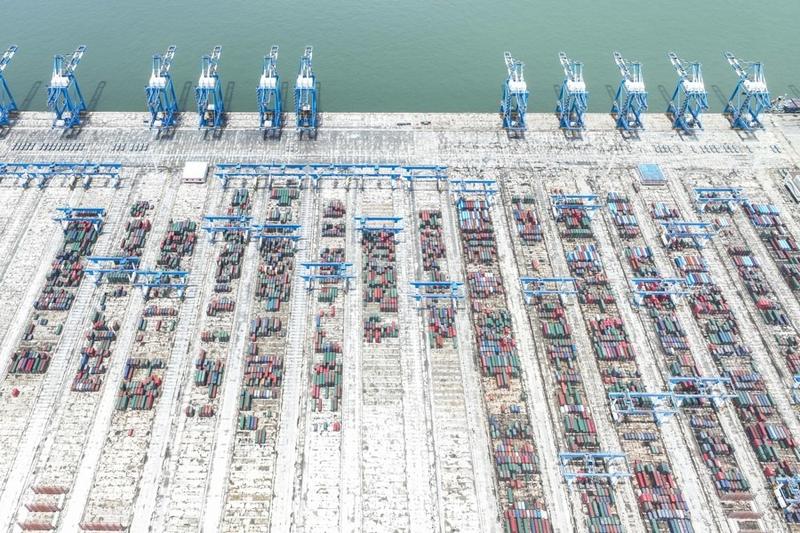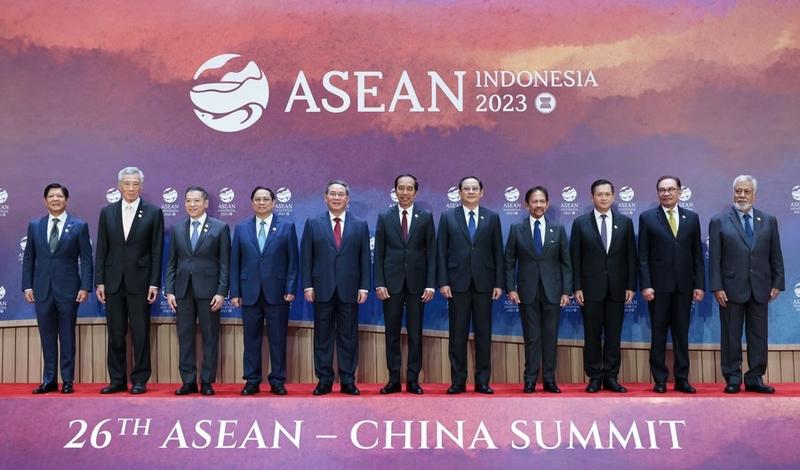 This aerial photo taken on July 22, 2023 shows an automated container wharf of the Beibu Gulf Port in Qinzhou, south China's Guangxi Zhuang autonomous region. (PHOTO / XINHUA)
This aerial photo taken on July 22, 2023 shows an automated container wharf of the Beibu Gulf Port in Qinzhou, south China's Guangxi Zhuang autonomous region. (PHOTO / XINHUA)
Southeast Asian leaders have closed this year’s ASEAN Summit by committing to strengthen the region as the epicenter of global growth, with analysts agreeing it is poised to become one of the key drivers of the world economy.
The Association of Southeast Asian Nations’ goal is all the more ambitious as it comes in the middle of an economic slowdown but analysts pointed to the region’s growing population, rising investments, and technological advancement as factors in its global role.
At the same time, ASEAN can learn from China’s rise to become the world’s second-biggest economy, while strengthening bilateral ties can also benefit both sides, analysts said.
The 43rd Association of Southeast Asian Nations Summit concluded last week in Jakarta, Indonesia, with the adoption of the ASEAN Leaders’ Declaration on ASEAN as an Epicentrum of Growth
The 43rd Association of Southeast Asian Nations Summit concluded last week in Jakarta, Indonesia, with the adoption of the ASEAN Leaders’ Declaration on ASEAN as an Epicentrum of Growth.
ALSO READ: Cooperation with China to stay strong, says ASEAN chief
ASEAN leaders agreed to navigate and respond to global challenges and unleash the region’s full growth potential amidst the megatrends likely of shifting and rebalancing of global economy. They also reaffirmed their efforts to strengthen resilience against future shocks, leverage new growth drivers, and embrace a forward-looking and future-proofed ASEAN agenda.
Josua Pardede, chief economist at the Jakarta-based Permata Bank, said China and ASEAN’s growth is “co-dependent” as China is a major trade partner and investment source for ASEAN. He said Chinese investment focuses on the manufacturing sector, establishing an industrial supply chain in the region and spurring economic growth.
“It also helps ASEAN countries to advance their quality of production as well as their capabilities. In the future, this could help Southeast Asian countries enjoy a new level of economic advancement – supporting them to become the center of economic growth,” Pardede said.
Erica Tay, an economist at Malaysia’s Maybank Investment Banking Group, said people and technology are the two forces propelling Southeast Asia’s growth in the next decade.
ALSO READ: 'Fruitful outcomes' as ASEAN summit ends in Jakarta
She said the Philippines, Indonesia, Malaysia, and Vietnam are poised to reap demographic dividends thanks to their sizeable and growing working-age populations. A young demographic combined with improving education and an influx of capital investment can create a large and highly skilled labor pool for global supply chains.
“As wages rise, and more workers enter the ranks of the middle class, Southeast Asia will also come into its own as a key consumer market,” Tay said.
 Chinese Premier Li Qiang poses for a group photo with participants attending the 26th China-ASEAN Summit in Jakarta, Indonesia, Sept 6, 2023. (PHOTO / XINHUA)
Chinese Premier Li Qiang poses for a group photo with participants attending the 26th China-ASEAN Summit in Jakarta, Indonesia, Sept 6, 2023. (PHOTO / XINHUA)
She added that advances in connectivity will also allow ASEAN countries to overcome geographical barriers and market fragmentation. As such businesses in the region can “achieve unprecedented scale” by serving customers online.
Tay said China has shown, through its global dominance in electric vehicle production, that its companies are a source of cutting-edge innovation. She said Chinese tech giants were global leaders in e-commerce and shared mobility.
ALSO READ: Key facts about China-ASEAN cooperation
“There is immense scope for China and ASEAN economies to work together in these areas. Southeast Asian firms can learn from China’s leading companies, not just in terms of their technological prowess,” Tay said, pointing to know-how in scaling up businesses and prevailing in fiercely competitive markets.
“In turn, Southeast Asia can be a lucrative key market and overseas base for Chinese firms going global,” she added.
Hafidzi Razali, director of BowerGroupAsia, said China can support ASEAN as an “enabler of development”. He said China can provide financing, project expertise, and knowledge transfer.
The World Bank forecast global growth to slow by 3 percent this year on the back of high inflation, tight monetary policy, and more restrictive credit conditions. Advanced economies, which include the United States and Europe, are expected to grow by 1.5 percent. Developing Asian economies, which include China and ASEAN, are expected to surpass global growth, with GDP projected to expand by 5.3 percent.
ALSO READ: China seeks to seal upgraded FTA talks with ASEAN by 2024
The International Monetary Fund’s Managing Director Kristalina Georgieva, in her report delivered at the plenary session of the 43rd ASEAN Summit, said ASEAN countries are contributing 10 percent to global growth, or more than twice their weight in the global economy. She said this is due to economic reforms implemented in the region.
“If China’s economic power is put together with the power of the ASEAN economy, it would not be an exaggeration to say that China and ASEAN will be the leader of global economic growth, while the US economy and the European economy will see low growth and will continue to slow down,” said Sawidji Widoatmodjo, dean of the school of economics at Tarumanagara University in Indonesia.
“It is probable that in the future the growth center will relocate to the Asia-Pacific region, and eventually the region will take over the position of the US and Europe, and become a place of developed countries,” Sawidji said.
Geoffrey Williams, professor and dean of the Institute of Postgraduate Studies at the Malaysia University of Science and Technology, said the US and Europe were once viewed as the engines of the global economy owing to their high per capita income and huge consumer demand. But this trend has changed, as there’s a shift in global demand, with China, India, and ASEAN collectively providing big markets.
READ MORE: Li: China, ASEAN should jointly build economic growth center
“Although per capita incomes (in developing Asia) are lower, the billions of consumers make these very large markets,” Williams said. He added that Asian countries are benefiting from high growth, relatively young populations, and an educated workforce.
“China is of course a major economic force not just in Asia but globally. It will remain a major force because of its size and growth as well as its influence politically and through the Belt and Road (Initiative) investments. In this way it can support ASEAN through trade and investment,” he said.
Williams added that ASEAN’s growth “must be broadly based”, and the region also has to nurture trade with the US, Europe, the Middle East, and India.
Leonardus Jegho in Jakarta contributed to this story.



